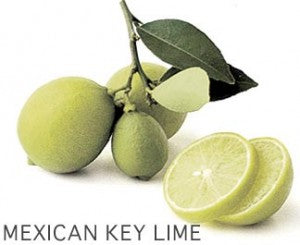LIMES
Australian Finger “Lime” (Microcitrus australasica)


This somewhat thorny, tiny leafed relative of citrus produces finger-like fruit with tart, round, juicy, light colored vesicles. Sometimes called “citrus caviar,” flavor is reminiscent of Mexican lime. Primary fruiting season in California is November-December. Has white and pink flowers May-July.
__________________
Bearss Seedless Lime (Tahiti/Persian)

True lime. Fruit larger than Mexican lime. Good in cool areas. This is the lime bartenders use and is the normal lime found in the store. Yellow is the ripe color.
______________________________
Mexican Lime (Key) 
Small, sometime seedy fruit with genuine tropical flavor year-round. Frost sensitive.
__________________________
Mexican Sweet Lime 
Round, thin-skinned fruit is sweet, juicy and nearly acidless. Easy to eat out of hand. Kids love them.
_____________________________________________________
Rangpur Lime 
Tart reddish orange fruit is used like lime, although it is a sour Mandarin from India. The overlap of prolific fruit and purple tinged blooms make this a wonderful ornamental tree. Popular in mixed drinks or simply sliced for ice tea.
______________________________
Yuzu

Also known as Japanese Citron. In the fall, this thorny tree produces lumpy, medium-sized, yellow to orange fruits that are uniquely fragrant and highly prized as flavoring agents in Asian cuisine, and for marmalade. Lots of seeds which are great to use instead of pectin as a thickener. Trees are among the cold-hardiest of all citrus.
_______________________________
Eustis Limequat

A cross between Mexican (Key) Lime and kumquat. Prolific bearer of small yellow oblong fruit, which can be used like limes. Fruit is small and sour and looks like the name should be “Lemon Drop”.
_____________________________
Kieffer Lime (Kaffir Lime) [IN]
Kieffer Lime trees are also known as Kaffir, “Makrut,” Thai lime and “Wild” lime.
Their leaves, zest, and juice are used in Thai, Cambodian, and Indonesian cooking. The zest of the bumpy fruit used in curries.
Kieffer (Kaffir) Lime Leaf and Peel
(Bai Ma-gkood, PewMa-gkrood)
The following is from an extraordinary book by Kasma Loha-unchit, It Rains Fishes: Legends, Traditions and the Joys of Thai Cooking, published by Pomegranate Artbooks, 1995. The widely distributed book contains bright watercolors punctuating tempting recipes and tales of life in rural Thailand. For more information, read the excerpts below, then check out her web site, Adventures in Thai Cooking and Travel: http://www.thaifoodandtravel.com/.
“Both the exceptionally fragrant fruits and leaves of the kaffir lime tree play important roles in Thai cooking, imparting unique flavors that have become identified with the cuisine. Any Thai cookbook that alludes to the use of citrus leaves really means kieffer lime leaves, the only citrus leaves used with regularity in a wide array of favorite Thai dishes. The luscious perfume and striking flavor of the leaves cannot be easily substituted with other kinds of citrus leaves. They are worth seeking, as their special attributes are irreplaceable.
The kieffer lime fruit approximates the size of a Western lime. The fruit is dark green in color and has a bumpy surface. Though the juice is seldom used in cooking, the peel of the fruit, with its high concentration of aromatic oils, is indispensable in many curry pastes and is one reason why Thai curries taste refreshingly unique. The zest also imparts a piquant flavor to such delectable favorites as fried fish cakes, and it blends in powerfully with spicy, chili-laden stews such as “jungle soup” (gkaeng bpah). Because its strong flavor can overpower the more subtle ones in a dish, the rind should be used sparingly, grated or chopped finely and reduced in a mortar with other paste ingredients until indistinguishable.
The leaves of the kieffer lime tree are a dark green color with a glossy sheen. The leaves are double-lobed and the top leaflets are slightly pointed. The leaflet attached below is broadened on its upper edge. The size of the leaves can vary quite a bit, from less than an inch to several inches long. The medium to large size, more mature leaves are darker in color and usually preferred for cooking.
Kieffer lime leaves are indispensible in many Thai dishes, from soups and salads to curries and stir-fried dishes. Their flavors blend marvelously with lemon grass and lime juice in dtom yam soup, imparting its characteristic wholesome lemony essence. In soupy dishes, add the leaves whole or torn into smaller pieces, using them as one would bay leaves to flavor broth or stew. For dishes in which they are a component to be eaten, such as salads, stir-fries and dry or custard like curries, cut them in very fine needle-like slivers, so that their strong bouquet can be more evenly distributed. The slivers also provide a pleasing texture and appearance.
To sliver kieffer lime leaves finely, stack three to four leaves of similar size together and slice them very thinly with a sharp knife. It is faster to cut diagonally, which also gives the hand better leverage. Alternatively, roll a few leaves at a time into a tight curl before slicing.
It can take a little practice to develop a sense of how to best to work with the leaves. It can be seen as a contemplative exercise and a way to become present with a wonderfully aromatic member of the botanical world. You can also try cutting the leaves with a pair of scissors, but this is a slower process, because you usually must cut one leaf at a time in order to get fine slivers. You may be tempted to mince or chop the leaves instead, but caution is advised with this method, since the kieffer lime leaf flavor can easily overwhelm more delicate flavors in a dish. It is best to use fine slivers about an inch long, as Thai chefs have done for generations.
Other Uses: In tropical Thailand, nearly every home in the countryside has a kieffer lime tree in the yard. Besides supplying great flavor ingredients to enhance food, kieffer lime fruits and leaves are commonly used in making effective household cleaners. A natural deodorizer, its sparkling scent is uplifting to the senses. Each scratch of the zest releases another installment of refreshing perfume.
Kieffer lime shampoo leaves the hair squeaky clean and invigorates the scalp. The invigorating scent is said to be effective in lifting one’s mental outlook as well as warding off evil spirits. Kieffer lime has also been used for ages as a natural bleach to remove tough stains. It is commonly known in Thailand that nothing works better on stubborn stains than a few drops of kieffer lime juice, mixed with a sprinkling of detergent. Not only does it clean effectively, it is inexpensive, natural and sweet-smelling. For rural villagers, a single kieffer lime tree supplies enough limes to keep the whole house and family clean.
In folk medicine, the juice of kieffer lime is said to promote gum health and is recommended for use in brushing teeth and gums. The essential oils in the fruit are incorporated into various ointments, and the rind is an ingredient in medical tonics believed to be good for the blood. Like lemon grass and galanga, the rind is also known to have beneficial properties for the digestive system.”
______________________________

